A close look at Omega's double
ridged rubber strap.
Since June, 17th 2003, I've been
the proud owner of a double ridged rubber strap for my Seamaster 300M.
Getting the strap wasn't particularly easy. The jeweller where I initially
got the watch from, completely denied its existence, and even said that a
rubber strap wouldn't be able to support a heavy watch like mine. Yeah, right.
I doubt we'll be doing a whole lot of business in the future.
But thanks to the internet, the WIS world is small. Jalle, who lives near
the polar circle, pointed me to a guy who runs his business in Germany, merely
200km away from me and has access to Omega spare parts. I won't name him here,
because I don't know if such a broad story about grey Omega spares might
get him in trouble. If you'd like to get a contact address, send me an e-mail.
This nice strap is so expensive it hurts, but after a number of alternative
straps, some of which I wasn't particularly happy with, I simply wanted the
original part from Omega. I paid €225,- for the strap and the clasp together.
I had also considered the "America's cup" style rubber strap, but abandoned
it because I wanted the more rugged option in the form of the double ridged
strap with its more secure clasp.
Let's have a look at the strap.
It comes in an awe-inspiring blister package, with a protective film on the
brushed surface of the clasp:
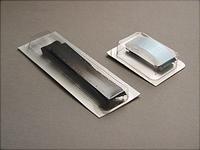
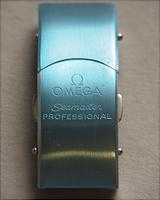
Here's close look at the whole strap. From the pictures I had seen on the
internet, I thought that it's bent so strongly near the lugs that the two
ridges come out flat. In reality, the ends are a bit cranked in order to accomodate
better to the wrist. The completely flat part contains a number of springbar
holes, each 5mm apart.
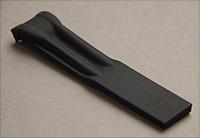
A very close look at the strap end that goes onto the watch:
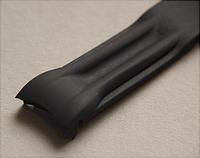
The strap is about as thick as the original bracelet:

On the inside of the strap, there's the well-known wave pattern, and a Seahorse
medaillion:
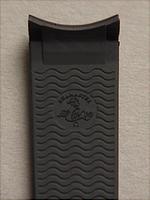
Here's the part that people usually find most unpleasant about the strap.
These are the marks between the springbar holes in the strap, where it has
to be cut to be sized. I don't exactly know what the numbers are for and
I'm not confident enough about measuring my wrist anyway, so I cut the strap
in single increments until it fit.
Sizing this strap isn't exactly a job for the faint of heart, but if you keep
a cool head and take a number of deep breaths, it shouldn't be a problem.
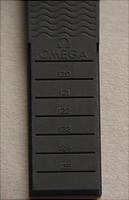
This is the unfolded clasp. It's stamped 1506/832 Stainless Steel.
I haven't yet found out what the numbers mean exactly, maybe you have some
information to share.
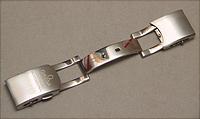
On the cut end of the strap, this part needs to be fixed, in order to attach
the strap to the clasp. I had had the big misconception that the strap is
held in the clasp by friction, but fortunately this didn't turn out to be
true.
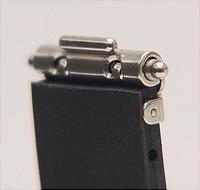
This is what the clasp looks like, closed, and with the pushbutton part open.
I wrote above that the strap is as thick as the bracelet, but that's a bit
misleading, because the clasp is very thick and very large. It's about two
or three times as massive as the clasp on the bracelet. If there's one thing
that's a bit problematic about this strap, it's the size of the clasp. The
good news, however, is that the clasp has a quick micro-adjustment facility
on both ends that offers 2cm of room for resizing the strap. So if you've
cut off an increment too many, or if your arms have a tendency to get thick
in summer, you still have a way to resize the strap, instead of having to
cut away another piece. ;-)
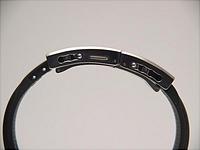
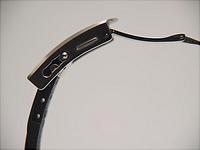
This is what the strap looks like on the watch. I haven't yet had the time
to produce a more sophisticated photograph, but you get the idea.
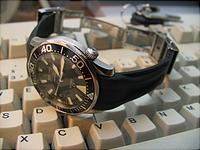
So, that's it for today. Thanks for reading, everyone.
h a c m a c @ f 0 0 . n e t
21.06.2003











